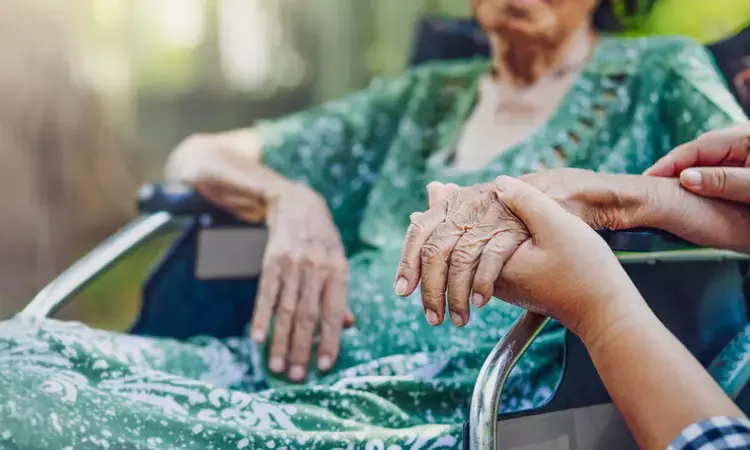- Home
- Medical news & Guidelines
- Anesthesiology
- Cardiology and CTVS
- Critical Care
- Dentistry
- Dermatology
- Diabetes and Endocrinology
- ENT
- Gastroenterology
- Medicine
- Nephrology
- Neurology
- Obstretics-Gynaecology
- Oncology
- Ophthalmology
- Orthopaedics
- Pediatrics-Neonatology
- Psychiatry
- Pulmonology
- Radiology
- Surgery
- Urology
- Laboratory Medicine
- Diet
- Nursing
- Paramedical
- Physiotherapy
- Health news
- Fact Check
- Bone Health Fact Check
- Brain Health Fact Check
- Cancer Related Fact Check
- Child Care Fact Check
- Dental and oral health fact check
- Diabetes and metabolic health fact check
- Diet and Nutrition Fact Check
- Eye and ENT Care Fact Check
- Fitness fact check
- Gut health fact check
- Heart health fact check
- Kidney health fact check
- Medical education fact check
- Men's health fact check
- Respiratory fact check
- Skin and hair care fact check
- Vaccine and Immunization fact check
- Women's health fact check
- AYUSH
- State News
- Andaman and Nicobar Islands
- Andhra Pradesh
- Arunachal Pradesh
- Assam
- Bihar
- Chandigarh
- Chattisgarh
- Dadra and Nagar Haveli
- Daman and Diu
- Delhi
- Goa
- Gujarat
- Haryana
- Himachal Pradesh
- Jammu & Kashmir
- Jharkhand
- Karnataka
- Kerala
- Ladakh
- Lakshadweep
- Madhya Pradesh
- Maharashtra
- Manipur
- Meghalaya
- Mizoram
- Nagaland
- Odisha
- Puducherry
- Punjab
- Rajasthan
- Sikkim
- Tamil Nadu
- Telangana
- Tripura
- Uttar Pradesh
- Uttrakhand
- West Bengal
- Medical Education
- Industry
Sarcopenia after hip fracture among elderly- An unsolved problem

Jung Wee Park et al found in a study that - after hip fracture, osteoporosis seemed to be well managed and the prevalence of osteoporosis did not increase. However, Skeletal muscle mass index (SMI) decreased and the prevalence of sarcopenia increased.
Sarcopenia is characterized by accelerated loss of muscle strength, function, and mass. It is associated with functional deterioration, falls, fractures, and death. Since October 2016, sarcopenia has been classified as a disease entity and was given an associated International Classification of Diseases (ICD) code, presenting a diagnostic challenge.
Among 1159 patients, who underwent surgery for low-energy hip fractures, 224 patients (38 men and 186 women with a mean age of 76.8±8.7 years) were studied with preoperative and follow-up dual-energy X-ray absorptiometry (DXA). Bone mineral density (BMD) and skeletal muscle mass were measured on DXA scans. The postoperative changes in the prevalence of osteoporosis and that of the sarcopenia were evaluated as well as Koval grade of the hip fracture patients.
The ambulatory function of patients was classified into two categories:
(1) outdoor ambulator: Koval grade I to III and
(2) housebound: Koval grade IV to VII (grade I: independent outdoor ambulator, grade II: outdoor ambulator with cane, grade III: outdoor ambulator with walker/crutches, grade IV: housebound independent ambulatory, grade V: housebound ambulator with cane, grade VI: housebound ambulatory with walker/crutches, grade VII: nonfunctional ambulatory).
The observations of the study were:
• While there was no significant change in BMD, SMI significantly decreased postoperatively.
• Mean decrease of the SMI was 0.53 kg/m2 in men and 0.38 kg/m2 in women.
• Prevalence of sarcopenia increased from 63 to 89% (p=0.014) in men and from 45 to 57% (p=0.006) in women.
• Lower BMI (Odds ratio (OR) 0.85 (95% confidence interval (CI) 0.76–0.96), p=0.008) and prior sarcopenia (OR 14.47 (95% CI 5.29–35.39), p< 0.001) were the risk factors for the decrease of SMI after hip fracture.
The authors concluded that - appendicular SMI decreased 8.2% in men and 6.7% in women 1 year after hip fracture. Prevalence of sarcopenia increased from 63 to 89% in men and 45–57% in women unlike the osteoporosis prevalence, which decreased after the hip fracture surgery. Previous diagnosis of sarcopenia was related to the aggravation of sarcopenia after hip fracture. More active measures should be considered to prevent sarcopenia in hip fracture patients.
Further reading:
Sarcopenia: an unsolved problem after hip fracture
Jung Wee Park, Hong Seok Kim et al
Journal of Bone and Mineral Metabolism (2022) 40:688–695
https://doi.org/10.1007/s00774-022-01334-6
MBBS, Dip. Ortho, DNB ortho, MNAMS
Dr Supreeth D R (MBBS, Dip. Ortho, DNB ortho, MNAMS) is a practicing orthopedician with interest in medical research and publishing articles. He completed MBBS from mysore medical college, dip ortho from Trivandrum medical college and sec. DNB from Manipal Hospital, Bengaluru. He has expirence of 7years in the field of orthopedics. He has presented scientific papers & posters in various state, national and international conferences. His interest in writing articles lead the way to join medical dialogues. He can be contacted at editorial@medicaldialogues.in.
Dr Kamal Kant Kohli-MBBS, DTCD- a chest specialist with more than 30 years of practice and a flair for writing clinical articles, Dr Kamal Kant Kohli joined Medical Dialogues as a Chief Editor of Medical News. Besides writing articles, as an editor, he proofreads and verifies all the medical content published on Medical Dialogues including those coming from journals, studies,medical conferences,guidelines etc. Email: drkohli@medicaldialogues.in. Contact no. 011-43720751


